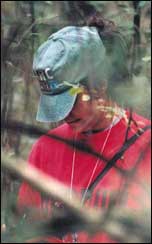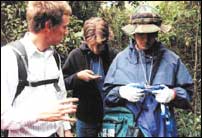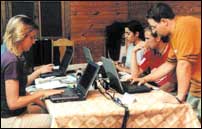 |
 |
 |
 |
|
AROUND THE QUADS
In order to expand the University's range in the biological sciences and enhance its role in the fields of ecology and evolutionary biology, Columbia has established the new Department of Ecology, Evolution and Environmental Biology. E3B, as the department is often abbreviated, began offering courses in the fall semester. Associate Professor Marina Cords, a zoologist and expert on primate social organization, is the department's chair. "The new department represents an important expansion for Columbia of both the biological sciences and environmental sciences," said David Cohen, vice president and dean of the Faculty of Arts and Sciences. The creation of the department reflects not only changes in biological research but also the practical considerations of teaching and research at the university level. In the first part of the 20th century, Columbia had a remarkable record in the study of organismal biology. The first Nobel Prizes for genetics and zoology went to Columbia professors. But by the late 1950s, the trend within biological research was away from entire organisms and toward the study of molecular and cellular biology. "Examining biological issues at the level of the organism began to wane," says Professor Donald Melnick, one of four faculty forming the core of the new department. "The number of people working on plants and animals was declining, and that happened here." In 1966, the Departments of Botany and Zoology were merged and renamed Department of Biological Sciences, which had the mission of building up molecular and cellular biology. Organismal biology shifted elsewhere — to museums of natural history, zoos, botanical gardens and other non-academic institutions. Recently, however, heightened concerns about the environment, biodiversity, viable ecosystems, habitat loss and others have rekindled interest in organisms. "There was more demand for these courses, and fewer and fewer people who could teach them," says Melnick. It was "a self-perpetuating problem." Through Melnick's efforts, in 1995 Columbia joined with four other New York institutions — the American Museum of Natural History, the New York Botanical Garden, the Wildlife Conservation Society (formerly known as the New York Zoological Society; i.e., The Bronx Zoo) , and the Wildlife Trust (formerly known as Wildlife Preservation Trust International) — to form a consortium, the Center for Environmental Research and Conservation. Based at Columbia, CERC's mission, says Melnick, was "creating this next generation of scientists, policy makers and informed citizens who were going to lead to a new way in which we would actually preserve much of our biological heritage." New York's strategic location played a big role: "No other city has this concentration of people doing things around the world," says Melnick.
The activities of CERC, which has a research and training faculty of more than 70 experts from the five institutions, led to the development of bachelor's, master's and doctoral degree programs at Columbia that now enroll nearly 75 students, including 30 undergraduate majors. Although most of these courses hadn't existed in 1995, by the 2000-2001 academic year, 155 students were enrolled in classes in these fields, of which 85 were undergraduates. CERC's success in offering undergraduate and graduate-level courses led to the creation of E3B. Although the Department of Earth and Environmental Sciences hosted the interdepartmental courses organized by CERC, as the number of students taking these courses grew, so did the rationale for creating a separate department. At Columbia, only departments (not schools) can appoint faculty, so it made sense to have a separate department with faculty dedicated to these fields. In addition, the interdepartmental program had to rely on the goodwill of other departments in administering its programs, which became more difficult as the number of courses and students increased. Finally, the new department allowed for "the crystallization of a group of people who didn't have a departmental home," says Melnick. Getting a new department off the ground isn't easy. Melnick notes that the last time Columbia created a department from scratch was in the 1940s. For E3B, the process began with an initial proposal to Cohen, who made suggestions and then sent it along to a University planning committee. The proposal was then circulated among all the chairs of departments and then the executive committee of the Faculty of Arts and Sciences. After their approval, it was circulated among the entire faculty, who approved it in September 2000. Cohen then submitted the proposal to Provost Jonathan Cole '64, who brought it before the University Senate's Education Committee, which approved it and sent it to the full Senate for a vote. After Senate approval, it was submitted to University President George Rupp, who brought it before the Board of Trustees for final approval in March 2001. All in all, the approval process took nearly two years.
The new department offers a rigorous program and remarkable opportunities for students. "The extraordinary field and laboratory research opportunities that these students have is really not matched at any other university," boasts Melnick. Among the five CERC partners, there are nearly 700 field sites globally from which students choose. Major students choose to do a research project, which is mentored by a research scientist from one of the five institutions. During the senior year, majors are expected to write their research in required senior theses. Majors also will be expected to take policy-related courses, usually in other departments (economics, law, political science) from a list drawn up by E3B. The hope is that students will learn how to "translate their results" to policy makers and civilians, says Melnick. E3B began with a core faculty of four including Professors Cords and Melnick, both of whom transferred from the Department of Anthropology (while keeping joint appointments), and three CERC research assistants. In addition, nearly 75 experts from other Columbia departments and CERC partners are eligible to teach courses in the new department. Cords says her first goal is to increase the size of the full-time faculty. She already has won approval to hire three new faculty members. Now that E3B is a full-fledged department, Cords also has begun the process of "thinking about all our programs afresh." Although E3B is a Columbia department, it benefits from its association with CERC. E3B and CERC share office space in the Schermerhorn Extension and will jointly raise money for new projects, fellowships and internships. E3B remains the degree-granting unit, however, and any adjunct or full-time faculty will be appointed through the department. The new department should enhance Columbia's position in the biological sciences. "This was an area that the University lost through quirk and history, but has now become extremely important," says Melnick. In the end, E3B became a reality, he says, because of "the energies of a lot of people — and a lot of good will." To learn more about E3B and CERC, visit their Web site: http://cerc.columbia.edu/.
|
|
||||||||||||||||||||||||||||||||||||||||||||||||||||||||||||||||||||||||||


